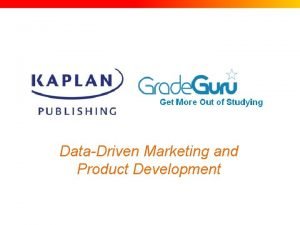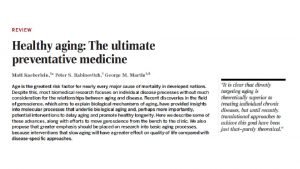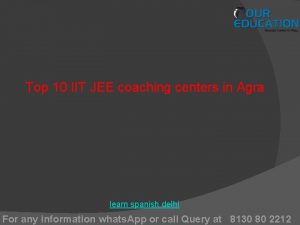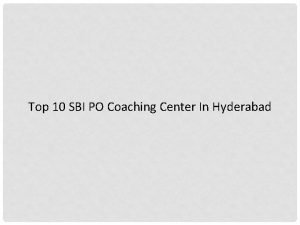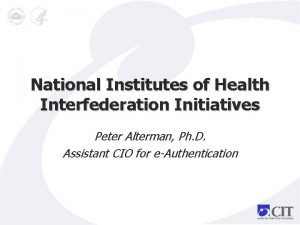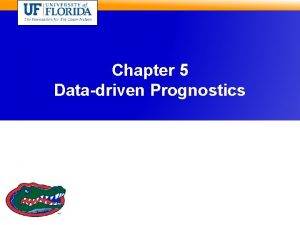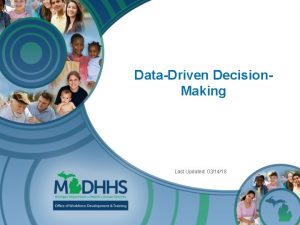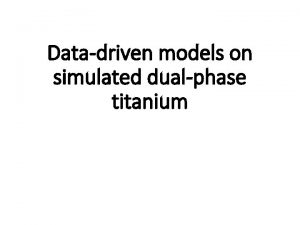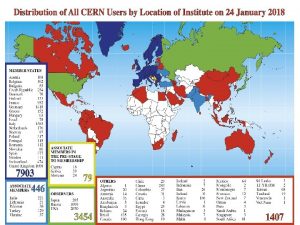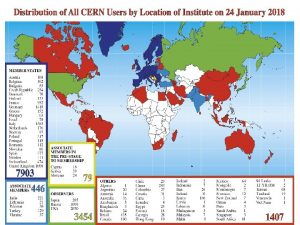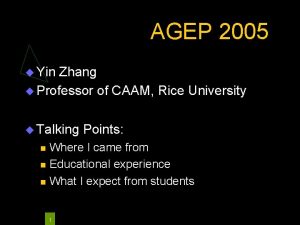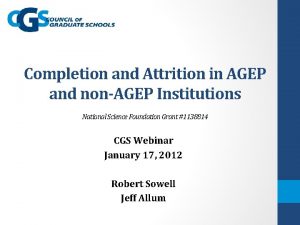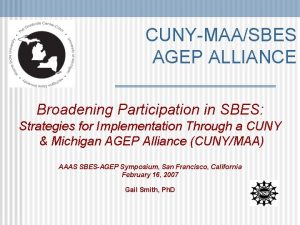AGEP DataDriven Learning Community American Institutes for Research
















- Slides: 16

AGEP Data-Driven Learning Community American Institutes for Research and Xcalibur

Introduction & Agenda 1 Introductions Today’s Discussion � Background, goals and expectations for community � Overview of longitudinal student tracking systems � Status of data collection and use at your institution/alliance � Challenges of data systems, collection and use � Goals and topics for future meetings

Goals of Learning Community 2 Background and history of AGEP-TS Learning community goals � Understand the needs of AGEP programs around student-tracking systems � Improve data-driven decision making for program improvement � Share data and best practices across AGEP programs

Characteristics and Benefits of Effective Learning Communities 3 Characteristics Effective facilitation/moderation Active participation and discussion Similar interests and goals Consistency in membership* Benefits Access knowledge Share knowledge Create knowledge Build relationships

AIR’s & Xcalibur’s Role 4 Community Organize and facilitate meetings Develop a Learning Community website � Resources � Further sharing � Open to AGEP community Summarize notes and prepare final memo AGEP-TS Provide technical assistance around the TS system Examine existing data to inform the community and NSF

Learning Community Participant Role 5 Attend calls Actively participate � Presentations, discussion, sharing of resources in calls and on web site JAM meetings (tentative & if in attendance) Anticipated schedule of calls Call 2—April/May 2012 Call 3—Oct/Nov 2012 Call 4—Feb/March 2012

Review: AGEP-Tracking System (TS) 6 What is it? �A database that provides a comprehensive resource for tracking AGEP student enrollment, graduation, and involvement in services/activities. Benefits � Easy to use and update (quick upload feature) � Generates AGEP reports instantly � Can be integrated with other AGEP-related reporting requirements to streamline data collection � Allows for sharing of effective practices across alliances (services)

Current Use of AGEP-TS 7 4 Alliances are actively using AGEP-TS: Facilitating Academic Careers in Engineering and Science (FACES) � Maryland PROMISE � Mississippi AGEP � More Graduate Education at Mountain States Alliance (MGE@MSA) � 5 additional Alliances have been trained and have access: Colorado AGEP � CUNY AGEP � Michigan AGEP � Midwest Crossroads � Student to Academic Professoriate for American Indians (SAPAI) �

Summary of Current TS Reports 8 Enrollment Reports � � � Number of Graduates Number of Students with Missing CIP Codes Services � � � � Enrollment Summary New Students Not Continuing Students Activity Summary Sheet Participation Summary by Service Category (Number of Students) Participation Summary by Service Category (Total Hours) Participation Summary by Service Category (Average Hours per Student) Participation Summary by Service Category Gender and Ethnicity (Number of Students) Participation Summary by Service Category Gender and Ethnicity (Total Hours) Participation Summary by Service Category Gender and Ethnicity (Average Hours per Student) Users � � User List with roles User List

9 Group Discussion

10 Please Talk About Your AGEP Data Collection Process(es) What types of data system(s) are you using to track your students currently? What are the benefits and drawbacks of each? What other, related reporting requirements do you need to meet?

11 How Do You Primarily Define “Success” in Your AGEP Programs? Recruiting Building capacity Retention Other? Graduation

How do you use the data you collect to inform AGEP programming? 12 How is it shared/discussed/used? How frequently do you look at it? What data do you turn to when you have questions about program effectiveness (e. g. what data are the “best”)?

13 Challenges & Barriers for Tracking AGEP Students Defining AGEP students Data Security Tracking students post-graduation Other Challenges?

Future Learning Community Meetings 14 Organize calls around 3 AGEP goals � Recruitment � Retention/time to degree � Graduation and beyond Organize calls around challenges Your thoughts

15 Learning Community Contact Information � Carlos Rodriguez crodriguez@air. org 202 -403 -5343 � Stephanie Lampron slampron@air. org 202 -403 -6822 � Matthew Murray mmurray@air. org 202 -403 -5198 � James Brown jbrown@xcalibur. com
 Datadriven marketing
Datadriven marketing Nih institutes and centers
Nih institutes and centers Iit coaching in agra
Iit coaching in agra National institutes of health
National institutes of health Wisconsin institutes of discovery
Wisconsin institutes of discovery European network of forensic science institutes
European network of forensic science institutes Top bank po coaching institutes hyderabad
Top bank po coaching institutes hyderabad National institutes for health
National institutes for health Cuadro comparativo entre e-learning b-learning y m-learning
Cuadro comparativo entre e-learning b-learning y m-learning Formuö
Formuö Typiska drag för en novell
Typiska drag för en novell Tack för att ni lyssnade bild
Tack för att ni lyssnade bild Returpilarna
Returpilarna Varför kallas perioden 1918-1939 för mellankrigstiden
Varför kallas perioden 1918-1939 för mellankrigstiden En lathund för arbete med kontinuitetshantering
En lathund för arbete med kontinuitetshantering Underlag för särskild löneskatt på pensionskostnader
Underlag för särskild löneskatt på pensionskostnader Vilotidsbok
Vilotidsbok
